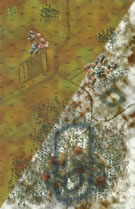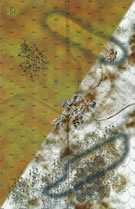|
Bring me the Head of St. John the Baptist Land Cruisers #6 |
||
|---|---|---|
| (Defender) Imperial Germany | vs | France (Attacker) |
| Formations Involved |
|---|

|
| Overall Rating, 1 vote |
|---|
|
4
|
| Scenario Rank: --- of 964 |
| Parent Game | Land Cruisers |
|---|---|
| Historicity | Alt-History |
| Date | 1940-09-20 |
| Start Time | 08:00 |
| Turn Count | 30 |
| Visibility | Day |
| Counters | 227 |
| Net Morale | 0 |
| Net Initiative | 2 |
| Maps | 2: 23, 24 |
| Layout Dimensions | 56 x 43 cm 22 x 17 in |
| Play Bounty | 209 |
| AAR Bounty | 223 |
| Total Plays | 1 |
| Total AARs | 0 |
| Battle Types |
|---|
| Inflict Enemy Casualties |
| Road Control |
| Urban Assault |
| Conditions |
|---|
| Entrenchments |
| Off-board Artillery |
| Randomly-drawn Aircraft |
| Reinforcements |
| Scenario Requirements & Playability | |
|---|---|
| Elsenborn Ridge | Maps |
| Fall of France 1 | Counters |
| Land Cruisers | Base Game |
| Introduction |
|---|
|
Halder considered exactly how to “cover up” the cruisers while awaiting a new directive for their use. In the end, he decided that, since there simply wasn’t anything smaller than a warehouse that would adequately cover the monstrosities, that he would cover them with dirt. Engineers from the 30th Infantry Division sweated and swore under the nighttime sky to get at least one of the cruisers covered. If they had known that this was simply an expedient while other plans were made, one expects that the swearing would have had a different target. While the Imperial Army juggled its senior leadership to punish the lack of operational security and rushed to “cover their tracks”, the French advance continued. The next offensive was against the German 30th Infantry Division which had been pinned to a few villages which had been reported to have “odd fortifications”. French intelligence reports could not agree on whether the armored fortresses encountered in Lorraine were huge vehicles, or static emplacements for heavy artillery. The French Second Army attached more of its infantry-support tanks to the III Armored Corps and ordered a renewed assault against the unusual German fortifications. The formal orders were the usual, to capture more “French” towns and continue to penetrate towards the Rhine. In a secret codicil to the orders, however,Corps command was instructed to use whatever force necessary to overcome one of these fortresses so that measures could be developed to counter them. As a result, the initial assault was to be supported by substantial reinforcements, if the weapons were discovered. “Whatever the Germans construct from steel, French élan will defeat.” The men of the III Armored Corps moved out to test that theory. Halder knew that the loss of the secret could change everything and prepared to resist the likely French assault. He, too, had reserves to commit. |
| Conclusion |
|---|
|
Despite repeated French assaults, the German line bent but held. The Germans engineers had dug in the cruisers well, protecting all but their heavily-armored turrets from anti-tank fire. The huge vehicles poured murderous fire on the advancing French; the Germans deployed light artillery in the front lines as ad-hoc anti-tank guns but would have been sorely pressed without the Land Cruisers. Both sides poured additional forces into the line as the French pushed to find out what these odd fortifications that seemed to move really were. Prince Franz remained unhappy with the deployment, Bock’s error had already ruined the element of surprise and there would have to be some quick reconfiguring of the operational priorities. Over night the decimated French units were withdrawn and Halder had the Land Cruisers withdrawn, including the damaged units which would be quickly repaired with the spare parts recently floated over the Rhine. At the same time, the French had been able to gain enough intelligence about the cruisers, their capabilities and their armaments to begin to develop responses to their use. Mostly, those responses appeared to be to avoid contact. The French did not again directly assault an area of the line where a Land Cruiser was present, deciding that it would be better to focus the attacks towards the communications of the Imperial Army, thus forcing the Land Cruisers to retire, albeit painfully slowly… |
| Additional Notes |
|---|
|
Special rules for Dug In Land Cruisers. Victory conditions can change depending on French losses, special rules for French capture of a Land Cruiser. |
| AFV Rules Pertaining to this Scenario's Order of Battle |
|---|
|
| 1 Errata Item | |
|---|---|

|
In 1940: Fall of France, the units show Direct Fire. All units are Indirect Fire. (rerathbun
on 2015 Jun 06)
|

 LaCr005
LaCr005 













































